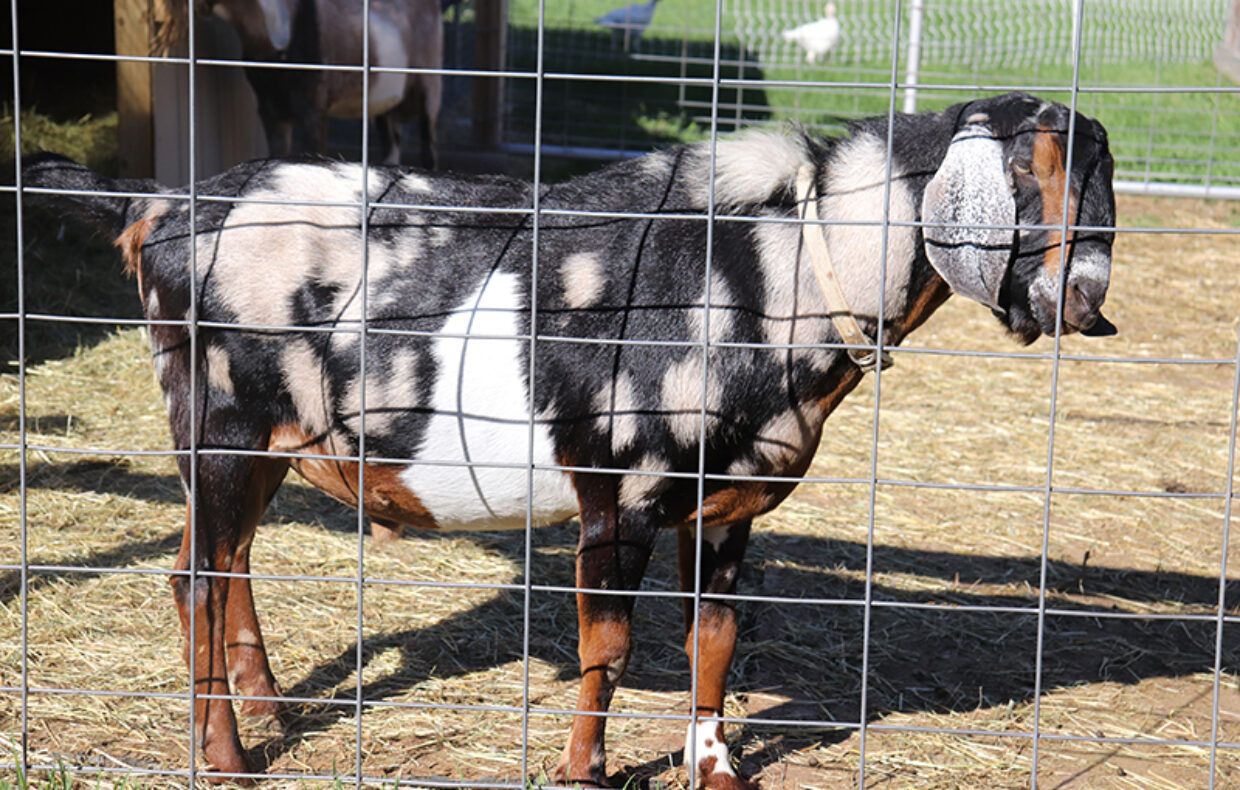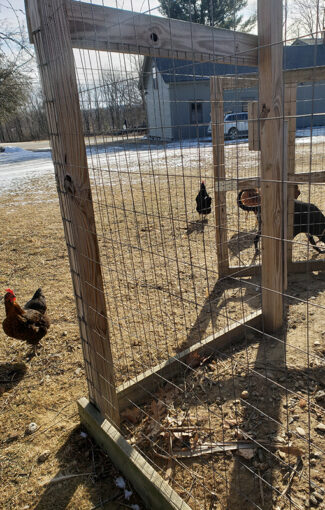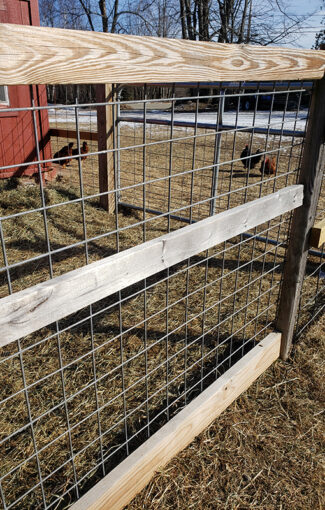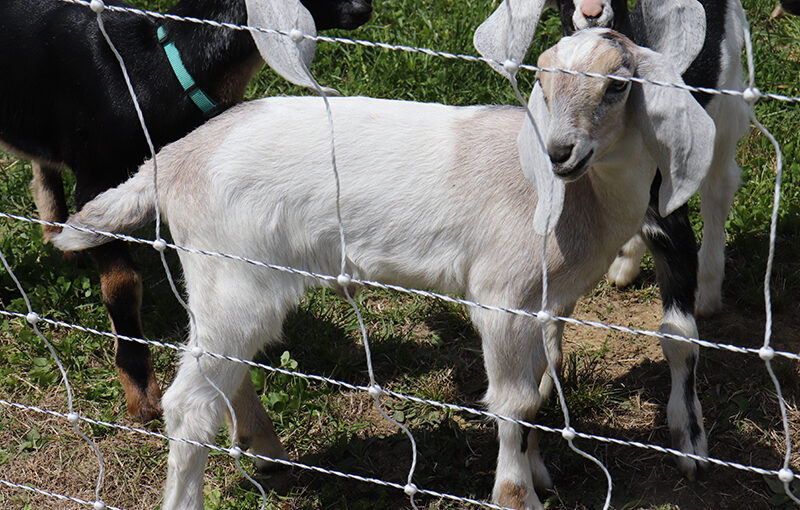Goat Fencing

They say of fencing for goats, “if it doesn’t hold water, it won’t hold your goats.” Kind of an intimidating thought, right?
Don’t fret. While keeping goats fenced in can be a challenge, it can be done. We are living proof.
As newbie goat owners we made all the mistakes you can think of. I’m going to give you some hints and tips to help you avoid those mistakes from the start.
Welded wire fencing:
 This is the rolled fencing you might find at your typical home store or garden center. It’s usually used for fencing dogs, chickens or to put around gardens. It has its’ uses but holding goats is not one of them. Welded wire fencing is exactly how it sounds…it’s heavy gauge wire welded together at the crosshairs.
This is the rolled fencing you might find at your typical home store or garden center. It’s usually used for fencing dogs, chickens or to put around gardens. It has its’ uses but holding goats is not one of them. Welded wire fencing is exactly how it sounds…it’s heavy gauge wire welded together at the crosshairs.
Nigerian Dwarf goats weigh between 60lbs and 85lbs or more while larger breed goats are 100lbs and up. Welded wire fencing isn’t made for that kind of weight. Goats will stand on fencing, which will eventually break. It won’t take long before they’ve created a hole and have escaped.
We learned this the hard way when we found our two full size Nubian bucks in the same pen together one day. It was early mating season, and both were bloodied. They had broken the wire between the two pens and the bigger buck pushed his way through the hole. Let’s just say the younger buck was not happy about the intrusion.
Lesson learned.
Upside to welded wire fencing: price. These come in rolls and are the least expensive of fencing.
Downside: You get what you pay for when it comes to keeping your goats corralled.
Enter Feedlot Cattle Panels.
These thick 4-gauge galvanized wire fence panels are heavy duty and built to last longer than your typical welded wire fencing. They come in 8’ and 16’ lengths and are 50” tall. They have graduated sized spaces starting with 8”x4” to 8”x6”.
The upside to these panels is their durability. They are made for cattle so are sturdy enough to handle even our full-sized does.
Downside: Cost. While not the most expensive of options, each 8’ panel runs about $18 and a 16’ panel is around $24.00. Also, the 8”x6” openings are big enough for baby goats to escape. (Another lesson learned…the hard way!)

4×4 panels properly on inside of wood frame
4×4 Utility Panels
We thought we finally had our answer to fencing with the feedlot cattle panels and they do work well; however, the bucks are still able to bend the wire when they stand on it.
We then transitioned to 4”x4” 6-gauge utility panels for the boys. These galvanized panels are thicker and reinforced with smaller holes to hold the weight of a full-size buck. While more expensive they were worth the cost for using in the boys’ pen areas. We also use these panels for our hay feeders. The 4×4 inch squares are large enough for the does to poke their noses through to get the hay without the ability to pull too much of the hay through and have it wasted on the ground.
Due to the cost, we only use these panels where other options have failed, but they are well worth it for those areas that call for extra reinforcement.
Electric Netting
Electric netting is widely used for rotational grazing and we use the Premier 1 PermaNet double spike fencing with a solar charging battery. This allows us to move the goats every few weeks. We use the PermaNet fencing as it has stronger PVC poles that handle the constant winds and wear and tear our fencing goes through.
We train our kids to the fencing as soon as they are old enough to be out in the field with the older does. Our older does understand that they are safe inside the fence and don’t usually try to escape. “Usually” being the operative word here.
The bottom row of the electric netting is not charged. The does know this. If there is enough of a gap between the ground and that bottom wire, and there is something tempting on the other side of the fence to eat, they will try to sneak under the fence. More than once we have found one of our goats on the “wrong side of the fence.”
Nigerians, being lower to the ground, are especially adept at sneaking under the wire. Our Maggie is very good at finding that one weak spot to sneak under. The trick here is not to punish your goats for getting out. Let’s face it. No matter how nimble we think we are, our goats can out maneuver us with ease. If they know they will be punished for escaping, they will just run from you. Not fun times.
Each time one of our goat gets out, we simply (and patiently) walk up to them, grab their collar and walk them back to the barn. We may give them a little treat and then set them back out to the field. Then we find the area where they snuck out and fix it. Problem solved.
The upside to using the electric netting is mobility. We rotationally graze our goats and the netting works great for this. They aren’t cheap. A hundred-foot roll will set you back more than $150.00. But when you need a movable fence, your options are limited. The solar battery will also set you back a pretty penny. I can say if care is taken, your fencing will last several years. We had to change the battery in our solar charger after 3 seasons.
Downside includes not only the cost but wildlife damage. We’ve had wild turkey and deer get stuck in our fencing. The deer usually break through, breaking the plastic wrapped wire strands. The turkeys aren’t usually so lucky. There are repair kits you can use to fix the breaks in the wire.
 A word on fence posts.
A word on fence posts.
We started with 3×4 inch wooden posts. Let me save you some time and effort. Don’t bother.
We moved up to 4×4 wooden posts for the does’ winter fenced area with the cattle panels. We reinforced it with 2×4’s running horizontally. I strongly suggest you use 6×6 inch posts for any bucks you have. Also use 6×6 inch posts for your gates. It may seem like overkill but trust me…it’s not.
Barbed Wire Fencing?
We don’t use nor recommend barbed wire fencing. There are too many risks with our animals getting hurt. We also don’t wish to harm any of the wildlife that roam through our farm.
What about woven wire fencing?
Woven wire fencing is good for permanent pastures. It is not welded so it is less likely to break. I would still not use it for bucks, but for does it is fine. Make sure you use sturdy posts and it is at lease four feet tall.
Reply